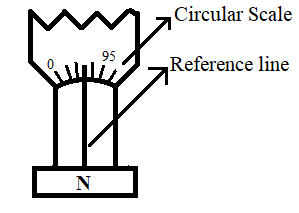
What is the zero error in the diagram?

$\begin{align}
& \text{A}.+0.03mm \\
& \text{B}.-0.03mm \\
& \text{C}.+0.03cm \\
& \text{D}.-0.03cm \\
\end{align}$

Answer
575.4k+ views
Hint: Zero error of screw gauge is a mechanical error. It occurs when zero of the circular scale does not coincide with the reference line of the main scale. To find the zero error, we check the coinciding reference line and circular scale and find the difference and multiply with least count.
Least count of screw gauge is the smallest distance moved by it when it is rotated through one division.
Formula used: $\text{Zero Error=Difference }\!\!\times\!\!\text{ Least Count}$
Complete step by step answer:
In the figure above, we have a screw gauge as said in the question.
Here from the given figure we can understand that zero of circular scale is above the reference line.
We know that when the zero of the circular scale is above the reference line, the zero error is negative.
Now, let us calculate the negative zero error here.
Zero error can be calculated using the formula
Zero error = Difference × Least count
Here, the difference is the total number of divisions – Coinciding circular scale division.
We can find the coinciding circular scale division from the figure.
By counting from 95 in the given figure, we get the coinciding circular scale division as 97
We know total number of circular scale division = 100
Therefore,
Difference = 100-97=3
Now, we need to calculate the least count of the screw gauge,
We know,
$\text{LC=}\dfrac{\text{pitch}}{\text{no}\text{.of}\text{.divisions}\text{.of}\text{.circular scale}}$
Therefore, here the least count of the screw gauge is,
Least count $=\dfrac{1mm}{100}=0.01mm$
Hence we have zero error as,
Zero error $=3\times 0.01mm$
Zero error$=0.03mm$
Since here the error is negative,
Zero error$=-0.03mm$
So, the correct answer is “Option D”.
Note: A screw gauge has three types of zero error. Zero zero error, positive zero error and negative zero error.
Negative error is discussed in the question above. When zero in the circular scale is above the reference line, then we have negative zero error.
Zero error of a screw gauge becomes zero, when the reference line perfectly coincides with zero in the circular scale of the screw gauge. In such a case the screw gauge is said to be free from zero error.
Positive zero error occurs when zero in the circular scale lies below the reference line. Positive zero error can be found by taking the product of the coinciding circular scale division and least count.
Least count of screw gauge is the smallest distance moved by it when it is rotated through one division.
Formula used: $\text{Zero Error=Difference }\!\!\times\!\!\text{ Least Count}$
Complete step by step answer:
In the figure above, we have a screw gauge as said in the question.
Here from the given figure we can understand that zero of circular scale is above the reference line.
We know that when the zero of the circular scale is above the reference line, the zero error is negative.
Now, let us calculate the negative zero error here.
Zero error can be calculated using the formula
Zero error = Difference × Least count
Here, the difference is the total number of divisions – Coinciding circular scale division.
We can find the coinciding circular scale division from the figure.
By counting from 95 in the given figure, we get the coinciding circular scale division as 97
We know total number of circular scale division = 100
Therefore,
Difference = 100-97=3
Now, we need to calculate the least count of the screw gauge,
We know,
$\text{LC=}\dfrac{\text{pitch}}{\text{no}\text{.of}\text{.divisions}\text{.of}\text{.circular scale}}$
Therefore, here the least count of the screw gauge is,
Least count $=\dfrac{1mm}{100}=0.01mm$
Hence we have zero error as,
Zero error $=3\times 0.01mm$
Zero error$=0.03mm$
Since here the error is negative,
Zero error$=-0.03mm$
So, the correct answer is “Option D”.
Note: A screw gauge has three types of zero error. Zero zero error, positive zero error and negative zero error.
Negative error is discussed in the question above. When zero in the circular scale is above the reference line, then we have negative zero error.
Zero error of a screw gauge becomes zero, when the reference line perfectly coincides with zero in the circular scale of the screw gauge. In such a case the screw gauge is said to be free from zero error.
Positive zero error occurs when zero in the circular scale lies below the reference line. Positive zero error can be found by taking the product of the coinciding circular scale division and least count.
Recently Updated Pages
Why are manures considered better than fertilizers class 11 biology CBSE

Find the coordinates of the midpoint of the line segment class 11 maths CBSE

Distinguish between static friction limiting friction class 11 physics CBSE

The Chairman of the constituent Assembly was A Jawaharlal class 11 social science CBSE

The first National Commission on Labour NCL submitted class 11 social science CBSE

Number of all subshell of n + l 7 is A 4 B 5 C 6 D class 11 chemistry CBSE

Trending doubts
What is meant by exothermic and endothermic reactions class 11 chemistry CBSE

10 examples of friction in our daily life

One Metric ton is equal to kg A 10000 B 1000 C 100 class 11 physics CBSE

1 Quintal is equal to a 110 kg b 10 kg c 100kg d 1000 class 11 physics CBSE

Difference Between Prokaryotic Cells and Eukaryotic Cells

What are Quantum numbers Explain the quantum number class 11 chemistry CBSE




